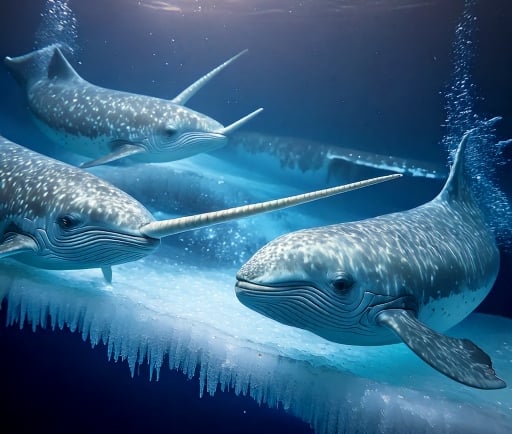Narwhal: The Unicorns of the Arctic Ice


Introduction to Narwhals: The Unicorns of the Ice
The narwhal, often dubbed as the unicorns of the ice, is a fascinating marine mammal found in the frigid waters of the Arctic. Recognizable by its long, spiral tusk, which is actually an elongated tooth, the narwhal has intrigued scientists and animal enthusiasts alike for centuries. These remarkable creatures emerge from beneath the ice-covered ocean, showcasing their unique anatomy in an enchanting display.
Habitat and Behavior of Narwhals
Narwhals typically inhabit the cold waters of the Arctic, primarily around Greenland, Canada, and Russia. They are known to spend much of their lives in deep waters, frequently diving in search of food such as fish and squid. Their natural habitat is characterized by drifting ice, which provides a perfect backdrop for their extraordinary emergence from the depths. These creatures can hold their breath for up to 25 minutes while diving, displaying an impressive adaptation to their icy environment.
The Significance of the Tusks
The most prominent feature of the narwhal is its long tusk, which can reach lengths of up to 10 feet. This tusk, primarily found in males, has been a subject of fascination and research. While it was once believed to serve exclusively as a weapon or for foraging, current studies suggest that the tusk may play a role in social interactions. Males often use their tusks to engage in a behavior known as “tusk jousting,” which helps establish dominance amongst peers. Additionally, the uniqueness of each tusk provides a means for researchers to identify individual narwhals, furthering our understanding of their populations and behaviors.
With their enchanting qualities, narwhals have also inspired various myths and folklore, being referred to as unicorns due to their striking resemblance to the mythical creature. Their fascinating characteristics and behaviors not only enhance their allure but also draw attention to the importance of protecting their fragile ecosystem.
Conservation Efforts and Challenges
Despite their intriguing nature, narwhals face numerous threats, primarily due to climate change and environmental disturbances. As ice levels decline, these creatures struggle to adapt to their changing surroundings, facing challenges in hunting and breeding. Various organizations and researchers are working diligently to understand the impacts of climate change on narwhals, advocating for their conservation and the preservation of their habitats.
In conclusion, the narwhal is a symbol of the mysteries of the Arctic, captivating humanity with its charm and unique adaptations. As we continue to study and learn about these enigmatic creatures, it is essential to prioritize their conservation for future generations to appreciate. By safeguarding their environment, we ensure that the unicorns of the ice will continue to emerge gracefully from the cold ocean waters, mesmerizing all who witness their extraordinary beauty.
